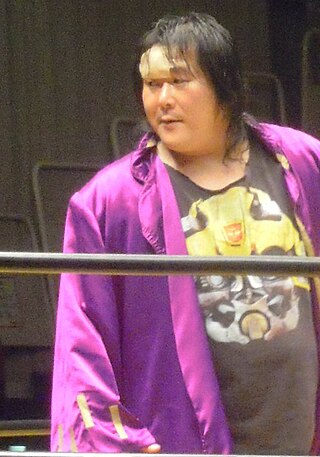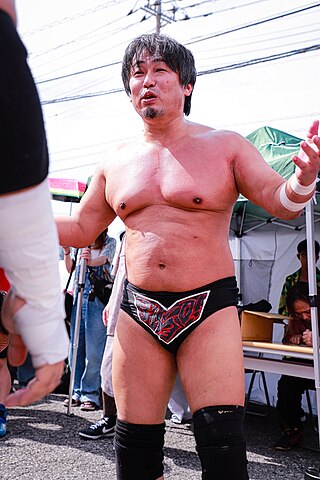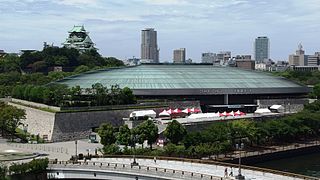
Michael Lee Alfonso was an American professional wrestler. He was best known for his appearances with the American professional wrestling promotions Extreme Championship Wrestling (ECW), World Championship Wrestling (WCW) and the World Wrestling Federation/Entertainment (WWF/E) under the ring name Mike Awesome and for his appearances in Japan with Frontier Martial-Arts Wrestling and All Japan Pro Wrestling as The Gladiator.

Eiji Ezaki was a Japanese professional wrestler, stage actor, musician and professional wrestling promoter, better known under the ring name Hayabusa. He was best known for his time with Frontier Martial-Arts Wrestling (FMW), where he primarily wrestled throughout his career and was the franchise player of the company between 1995 and 2001.

Atsushi Onita is a Japanese actor, politician, and semi-retired professional wrestler. He is best known for his work in Frontier Martial-Arts Wrestling (FMW) and is credited with introducing the deathmatch style of professional wrestling to Japan. He is a former All Asia Tag Team Champions alongside Yoshitatsu.

Masanori Morimura better known under his ring name Ricky Fuji is a Japanese professional wrestler currently signed to Action Advance Pro Wrestling, where he also runs the day-to-day operations. He is perhaps best known for his time with Frontier Martial-Arts Wrestling (FMW), where he wrestled between the promotion's early days in 1990 until the promotion's closure in 2002, making him the longest-tenured wrestler in the company's history.

Yukihiro Kanemura, better known by his ring name Kintaro Kanemura, is a Zainichi Korean retired professional wrestler. He also wrestled under the ring name Wing Kanemura. He is best known for his death matches in Apache Army, Big Japan Pro Wrestling (BJW), Extreme Championship Wrestling (ECW), Frontier Martial-Arts Wrestling (FMW), International Wrestling Association (IWA) and Wrestling International New Generations (W*ING).

Masashi Honda is a Japanese retired professional wrestler. He is best known for his work in Frontier Martial-Arts Wrestling (FMW) under the ring name Mr. Gannosuke.
Koji Nakagawa is a Japanese semi-retired professional wrestler best known for his work in Frontier Martial-Arts Wrestling (FMW) between 1992 and 2002. He is perhaps best known for his “Hitman” character, heavily inspired by Canadian professional wrestler Bret Hart. Nakagawa also wrestled as Goemon between 2000 and 2002, a dark thief character that was eventually killed and turned into a ghost in storyline.

Tetsuhiro Kuroda is a Japanese professional wrestler, currently competing as a freelancer on the Japanese independent circuit. He is best known for his time with Frontier Martial-Arts Wrestling (FMW), where he primarily competed from 1993 until the promotion's closure in 2002.
The W*ING Alliance was a Japanese professional wrestling group that existed in Frontier Martial-Arts Wrestling (FMW) between 1994 and 1997. The group consisted of wrestlers from the W*ING promotion, which ended in March 1994 due to FMW hiring the top tier talent of W*ING and the W*ING alumni wanted to avenge the demise of the company from FMW and the company's owner Atsushi Onita in storyline.

The FMW 5th Anniversary Show was a professional wrestling event produced by Frontier Martial-Arts Wrestling (FMW). The event took place on May 5, 1994 at the Kawasaki Stadium in Kawasaki, Kanagawa, Japan. This was the fifth edition of the company's flagship event Anniversary Show, commemorating the fifth anniversary of the company. It was the third edition of the event to take place at Kawasaki Stadium and took place on May 5 for the second consecutive year. May 5 would become a significant date for FMW like January 4 was for New Japan Pro-Wrestling (NJPW).

FMW 6th Anniversary Show was a professional wrestling event produced by Frontier Martial-Arts Wrestling (FMW), taking place on May 5, 1995 at the Kawasaki Stadium in Kawasaki, Kanagawa, Japan. This was the sixth edition of the company's flagship event Anniversary Show, commemorating the sixth anniversary of the company and the third consecutive and fourth overall edition of Anniversary Show at Kawasaki Stadium.

FMW 7th Anniversary Show was a professional wrestling event produced by Frontier Martial-Arts Wrestling (FMW), taking place on May 5, 1996 at the Kawasaki Stadium in Kawasaki, Kanagawa, Japan. This was the seventh edition of the company's flagship event Anniversary Show, commemorating the seventh anniversary of the company and the fourth consecutive and fifth overall edition of Anniversary Show at Kawasaki Stadium.

FMW 8th Anniversary Show was a professional wrestling event produced by Frontier Martial-Arts Wrestling (FMW). The event took place on April 29, 1997 at the Yokohama Arena in Yokohama, Japan. This was the eighth edition of the company's flagship event Anniversary Show, commemorating the seventh anniversary of the company. It was the second edition of the event at the Yokohama Arena after 3rd Anniversary Show in 1992 and the first time in four years that the event was not held at Kawasaki Stadium.

ZEN was a professional wrestling stable in Frontier Martial-Arts Wrestling (FMW). The group was led by former FMW owner and the company's founder Atsushi Onita from late 1997 to mid 1998 and the group was based on World Championship Wrestling's New World Order (nWo). The group produced its own shows in collaboration with FMW like nWo promoted its own pay-per-view nWo Souled Out.
Team No Respect was a professional wrestling faction in Frontier Martial-Arts Wrestling (FMW), which existed in the company between 1998 and 2000. The ideology of the group was that they disrespected all the wrestlers in FMW as well as the company's management and President Shoichi Arai. TNR was formed after Mr. Gannosuke, Yukihiro Kanemura and Hido turned on their ZEN leader Atsushi Onita out of jealousy with Onita due to his high ego and selfishness and formed a major alliance with Fuyuki-Gun. TNR was the most popular, successful and influential stable in the history of FMW and were involved in FMW's major storylines and rivalries during its two and a half year existence.
Super Extreme Wrestling War was a series of professional wrestling events produced by Frontier Martial-Arts Wrestling (FMW) in 1997. These events marked the first time that FMW began a partnership with American counterpart Extreme Championship Wrestling (ECW) and a working relationship began between the two companies as ECW wrestlers competed at these events and it marked the beginning of interpromotional matches and events between ECW and FMW. These events would create a huge impact in FMW's storylines as they concluded with the breakup of ZEN when Mr. Gannosuke, Yukihiro Kanemura and Hido attacked their leader Atsushi Onita out of jealousy after Hayabusa pinned Onita in a WarGames match. They merged with Fuyuki-Gun to form Team No Respect, which would dominate FMW until 2000.
Year End Spectacular (1993) was a major professional wrestling event produced by Frontier Martial-Arts Wrestling (FMW). The event took place on December 8, 1993 at the Tokyo International Trade Harumi Dome in Tokyo, Japan. This was the first Year End Spectacular event and would set the stage for future major events in FMW to close the month of December.

Summer Spectacular (1994) was the third Summer Spectacular professional wrestling event produced by Frontier Martial-Arts Wrestling (FMW). The event took place on August 28, 1994 at the Osaka-jō Hall in Osaka, Japan.
Summer Spectacular (1996) was the fourth Summer Spectacular professional wrestling event produced by Frontier Martial-Arts Wrestling (FMW). The event took place on August 1, 1996 at the Shiodome in Tokyo, Japan.

Fall Spectacular: Kawasaki Legend was a Fall Spectacular professional wrestling event produced by Frontier Martial-Arts Wrestling (FMW). The event took place on September 28, 1997 at the Kawasaki Stadium in Kawasaki, Kanagawa, Japan. The show aired via tape delay on Samurai TV! on October 12.















